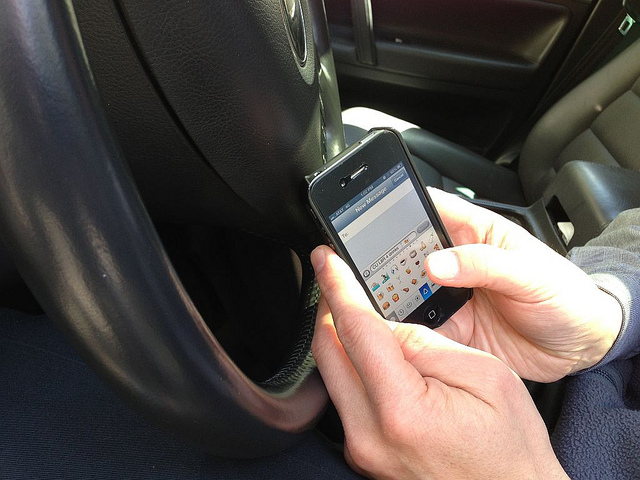
By Kurt Valentine, Staff Writer
If you live and work in a metropolitan area, you are bound to see people engaged in questionable activities during your commute. Some may use their rearview mirrors to do their best reenactments of a “Just For Men” commercial, and others might turn their dashboards into the Clinique counter at Macy’s. It is not uncommon to see people going through their entire morning routines. The most common distraction, however, is people using their cellphones.
If you look around in traffic, you can usually find someone looking down in their lap or holding their phone by the steering wheel while driving. One-third of drivers admit to texting while driving.[1] Using a cellphone while driving is extremely dangerous, and the law should reflect that danger.
In 2011, roughly one-fourth of all car accidents involved someone on a cellphone.[2] In Pennsylvania from 2010 to 2015, there have been 6,201 crashes, 3,869 injuries, and 54 fatalities from people texting while driving.[3] In March 2012, Pennsylvania passed legislation banning texting, emailing, browsing the internet, and instant messaging on handheld devices while driving.[4] The statute provides that anyone texting and driving will be fined $50 and will not be charged with a moving violation unless the offense results in an accident.[5]
Since the legislation was passed, there has been little change in the number of accidents caused by texting and driving. In 2011, before the bill was enacted, there were 1,111 accidents caused by drivers who were texting.[6] In 2015, there were only 95 fewer accidents.[7] This indicates that the current statute is not acting as a deterrent.
Pennsylvania representatives are aware that the current statute needs to be improved. Several have introduced bills to completely ban the use of handheld devices while driving.[8] Shortly after the current law was passed, Rep. Joseph Markosek introduced legislation calling for a complete ban on all handheld devices.[9] Since 2009, there has been legislation introduced every year that would call for such a ban. All efforts to achieve it, however, have failed.
Police officers have complained that the current law is difficult to enforce because it is legal to dial a phone number while driving.[10] An officer has to prove that someone is illegally texting and not legally entering a phone number.
A complete ban on all handheld devices is much easier to enforce. Pennsylvania issued roughly 1,300 tickets statewide in the first year of the law.[11] During that time, New York, which has a complete ban on handheld devices, issued around 55,000 tickets.[12] Texting laws are only effective for a few months after passing if they are not enforced.[13]
Handheld bans have proved to be more effective on the West Coast as well. A California study conducted during the first four years of the state’s handheld ban showed a 22 percent decrease in traffic deaths and a 47 percent decrease in deaths involving cellphones; there was a similar drop in physical injuries.[14]
Increased restrictions and penalties for using cellphones while driving are not going to completely eliminate the problem. People still drink and drive, people still excessively speed, and some people still do not use their seatbelts. Laws against those infractions have been in place for a long time, and police regularly enforce them.
Texting and driving, by comparison, is a new problem that police and the legislature have to address. Police officers have expressed their concerns with the current law, and legislators have come close to passing a handheld ban on a few occasions. Moreover, 43 percent of Pennsylvania drivers have said that distracted driving was the biggest threat on the road.[15] Evidence has shown that an easily enforced handheld ban makes the road safer. It is only a matter of time until the law catches up with the danger of the infraction.
Sources
[1] http://www.textinganddrivingsafety.com/texting-and-driving-stats
[2] http://www.textinganddrivingsafety.com/texting-and-driving-stats
[3] https://www.dotcrashinfo.pa.gov/PCIT/ReportDetails.html?param=111
[4] http://handsfreeinfo.com/pennsylvania-texting-law-detail/
[5] 2011 Bill Text PA H.B. 146
[6] https://www.dotcrashinfo.pa.gov/PCIT/ReportDetails.html?param=111
[7] https://www.dotcrashinfo.pa.gov/PCIT/ReportDetails.html?param=111
[8] http://handsfreeinfo.com/pennsylvania-cell-phone-laws-legislation/
[9] http://handsfreeinfo.com/pennsylvania-cell-phone-laws-legislation/
[10] http://handsfreeinfo.com/pennsylvania-cell-phone-laws-legislation/
[11] http://handsfreeinfo.com/pennsylvania-cell-phone-laws-legislation/
[12] http://www.post-gazette.com/news/transportation/2014/03/21/Allegheny-County-tops-state-in-texting-while-driving-citations/stories/201403210178
[13] http://www.citylab.com/commute/2013/03/do-texting-bans-really-prevent-fatal-accidents/5104/
[14] http://www.drivinglaws.org/pa-laws.php#
[15] http://www.post-gazette.com/news/transportation/2014/03/21/Allegheny-County-tops-state-in-texting-while-driving-citations/stories/201403210178